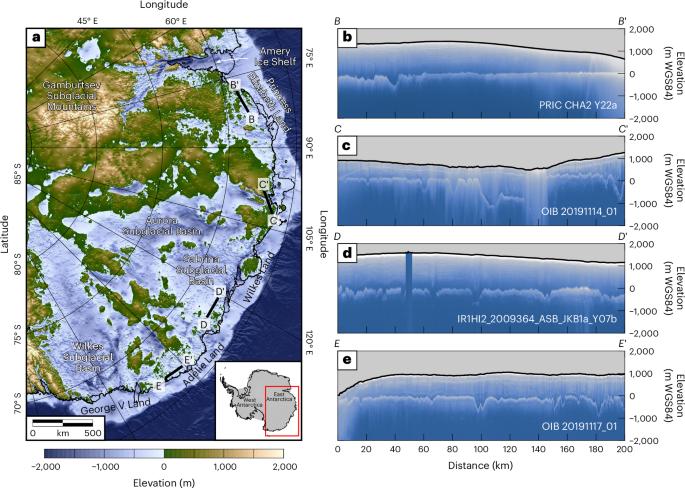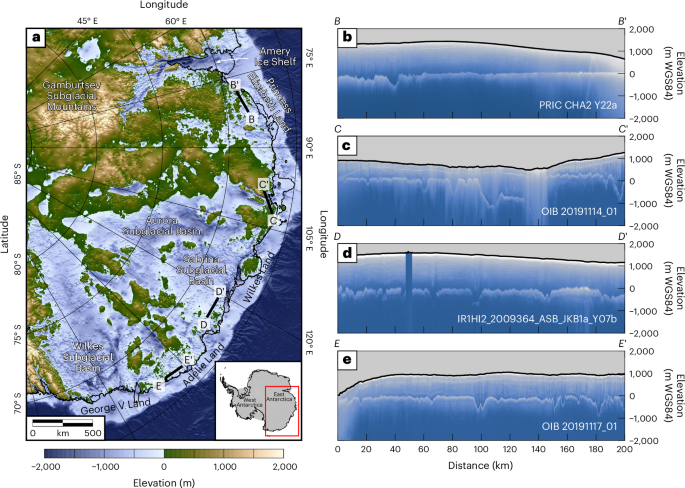东南极边缘广阔的河流表面调节了冰盖的演变
IF 16.1
1区 地球科学
Q1 GEOSCIENCES, MULTIDISCIPLINARY
引用次数: 0
摘要
南极床地形影响着上覆冰盖对气候变化的反应,并提供了长期冰川历史的记录。然而,关于冰川开始前控制景观发展的过程以及这一过程如何调节随后的冰盖演变的知识仍然有限。在这里,我们使用无线电回波探测来揭示东南极洲伊丽莎白公主地和乔治五世地之间冰缘下广阔的平坦表面。当它们的高度根据当前冰负荷的卸载进行均衡调整时,这些表面聚集在海拔200-450米的地方,并向近海方向缓慢倾斜。研究表明,这些表面是由河流侵蚀形成的曾经连续的海岸平原的碎片,其历史可以追溯到东南极洲与澳大利亚分离(~ 100-80 Ma)和南半球冰盖冰川作用(~34 Ma)之间。这些地貌的保存表明,在整个南极洲的冰川历史中,表面缺乏强烈的、选择性的侵蚀。相反,快速流动的冰被引导通过继承的构造结构和河流山谷,导致在平面之间切割过深的冰下沟槽,从而调节冰盖对气候变化的反应。本文章由计算机程序翻译,如有差异,请以英文原文为准。


Extensive fluvial surfaces at the East Antarctic margin have modulated ice-sheet evolution
Antarctic bed topography influences how the overlying ice sheet responds to climate change and provides a record of long-term glacial history. However, knowledge of the processes that governed the development of the landscape before glacial inception and how this modulated subsequent ice-sheet evolution remains limited. Here we use radio-echo sounding to reveal extensive flat surfaces beneath the ice margin between Princess Elizabeth Land and George V Land, East Antarctica. When their elevations are isostatically adjusted for unloading of the present-day ice load, these surfaces cluster at 200–450 metres above sea level and dip gently in an offshore direction. We show that the surfaces are fragments of a once-contiguous coastal plain formed by fluvial erosion, which dates from between the separation of East Antarctica from Australia (~100–80 Ma) and the onset of Southern Hemisphere ice-sheet glaciation (~34 Ma). The preservation of these landforms indicates a lack of intense, selective erosion of the surfaces throughout Antarctica’s glacial history. Fast-flowing ice has instead been directed through inherited tectonic structures and fluvial valleys, leading to the incision of overdeepened subglacial troughs between the flat surfaces and thus modulating the responsiveness of the ice sheet to climate change. Extensive flat surfaces observed beneath the East Antarctic Ice Sheet margin were formed by fluvial erosion and have modulated the ice-sheet response to climate change, according to an analysis of radio-echo sounding data.
求助全文
通过发布文献求助,成功后即可免费获取论文全文。
去求助
来源期刊

Nature Geoscience
地学-地球科学综合
CiteScore
26.70
自引率
1.60%
发文量
187
审稿时长
3.3 months
期刊介绍:
Nature Geoscience is a monthly interdisciplinary journal that gathers top-tier research spanning Earth Sciences and related fields.
The journal covers all geoscience disciplines, including fieldwork, modeling, and theoretical studies.
Topics include atmospheric science, biogeochemistry, climate science, geobiology, geochemistry, geoinformatics, remote sensing, geology, geomagnetism, paleomagnetism, geomorphology, geophysics, glaciology, hydrology, limnology, mineralogy, oceanography, paleontology, paleoclimatology, paleoceanography, petrology, planetary science, seismology, space physics, tectonics, and volcanology.
Nature Geoscience upholds its commitment to publishing significant, high-quality Earth Sciences research through fair, rapid, and rigorous peer review, overseen by a team of full-time professional editors.
 求助内容:
求助内容: 应助结果提醒方式:
应助结果提醒方式:


